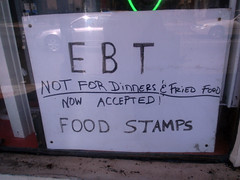Sociologists predict that half of all U.S. children will be on food stamps at some point in their childhood, according to the 
Philadelphia Inquirer.
In a stark and surprising finding, about half the children in the United States will be on food stamps at some point during their childhood, a new study of 29 years of data shows.
One in three white children and 90 percent of all black children – ages 1 through 20 – will use the program, according to the research, published this month in the Archives of Pediatrics and Adolescent Medicine.
“This means Americans’ economic distress is much higher than we had ever realized,” said Thomas A. Hirschl, a sociology professor at Cornell University and a coauthor of the study with Mark R. Rank, a sociologist at Washington University in St. Louis.
The survey finds that continued food-stamp usage signifies a kind of poverty that is “a threat to the overall health and well-being of American children, and, as such, represents a significant challenge to pediatricians in their daily practice.”
Although the data used in this study ends in 1997, and thus does not account for the current recession, these findings seem to correspond with a report published Monday by the U.S. Department of Agriculture:
The persistent poverty described in the survey dovetails with the findings of a U.S. Department of Agriculture study released Monday. It determined that 49 million Americans – 17 million of them children – were unable to consistently get enough food to eat in 2008. Nearly 15 percent of households were having trouble finding food, the highest number recorded since the agency began measuring hunger in 1995.
The study’s authors note that kids are often overlooked in U.S. social programs:
“The number-one poverty program in the United States is Social Security,” Hirschl said. “There is no such system for children.”
But how trustworthy is the prediction that 50% of all U.S. kids will use food stamps at some point in their childhood?
Because there was so much data, the authors were able to use a very long window of observation, which helped them extrapolate into the future about food-stamp usage, said John Iceland, a sociology professor at Pennsylvania State University. Iceland, who is familiar with the methodology used in the Hirschl-Rank paper, described it as “very solid work.”
“It’s like determining the likelihood of developing heart disease from health data,” Rank said.
The Michigan study is well-known and widely used by social scientists, and it has proven to be accurate over the years, Iceland said.
The finding that 50 percent of children will be on food stamps in their lifetime is conservative, Hirschl said.
That’s because only about 60 percent of households eligible for food stamps actually get them, a finding backed up by the newly released Department of Agriculture study. Stigma and ignorance of the program hold people back, he said.

Comments 5
Tweets that mention u.s. kids are hungry » Contexts Crawler -- Topsy.com — November 19, 2009
[...] This post was mentioned on Twitter by Thom, Contexts Magazine. Contexts Magazine said: Crawler: u.s. kids are hungry - http://bit.ly/42bAqc [...]
uberVU - social comments — November 20, 2009
Social comments and analytics for this post...
This post was mentioned on Twitter by ContextsMag: Crawler: u.s. kids are hungry - http://bit.ly/42bAqc...
All In One Information » u.s. kids are hungry » Contexts Crawler — November 20, 2009
[...] here: u.s. kids are hungry » Contexts Crawler This entry is filed under Kids. You can follow any responses to this entry through the RSS 2.0 [...]
chris uggen — November 20, 2009
i'm still trying to get my head around the numbers and methodology. it must be a stock and flow thing, since nowhere near 50% of u.s. kids are currently in families receiving food stamps. the 50% figure suggests a *lot* of movement in and out of assistance, which is plausible, and perhaps not surprising in light of the figures on free or reduced-price lunch in public schools.
Sarah Shannon — November 27, 2009
That sounds about right, Chris. Looking at the original article, the authors used life tables to estimate the risk of food stamp use between the ages of 1 and 20 for kids in the sample. Based on their analysis, they predict that "at some point during childhood" close to half of U.S. kids will live in a household that uses food stamps. They note that households that access food stamps tend to use the program for multiple short spells over time.